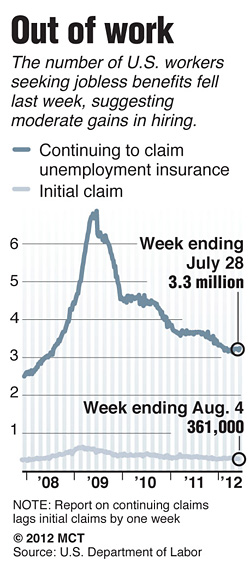 By Kevin G. Hall, McClatchy Newspapers –
By Kevin G. Hall, McClatchy Newspapers –
WASHINGTON — Hiring picked up much faster in July than expected. Car sales remain solid. Home prices are climbing again in parts of the country. It all points to a strong second half of 2012, right? Not necessarily.
Weighing against growth are the ongoing debt crisis in Europe, a clear slowdown in China and uncertainty over a bitter presidential election, expiring Bush-era tax cuts and the possibility of steep, across-the-board cuts in government spending.
That’s led most economists to predict sluggish growth at best for the latter half of the year, and some even whisper that recession is possible next year.
“It’s kind of what I call a very uncomfortable economy,” said Mark Zandi, the chief economist for forecaster Moody’s Analytics and a frequent witness before Congress.
Even Zandi’s silver lining — that construction will add growth in the second half of the year, pulling the annualized growth for the year to 2 percent or better, up from the second quarter’s 1.5 percent — “means we make no progress on unemployment.”
With the jobless rate at 8.3 percent, “it means the economy is very vulnerable to what could go wrong,” he said.
Kate Warne, an economist and market strategist for the investment firm Edward Jones, told a recent economic roundtable at the U.S. Chamber of Commerce that there are reasons for optimism, one of them being improvement in the housing sector. After several years of dragging against economic growth, it’s now contributing to it.
“I think we’re finally seeing housing stabilize,” she said.
The National Association of Realtors reported Thursday that the median sales price for existing single-family homes rose in the second quarter in 110 out of the 147 metropolitan areas it tracks, compared with the same three months last year.
But even that sign of improvement isn’t likely to lead to a return of good times in the latter half of the year. “We think we’re going to see more of the same,” Warne said.
Mark Vitner, a senior economist at Wells Fargo Securities, agrees that the “housing market has been a notable exception to the recent run of disappointing news.”
The company’s National Association of Home Builders/Wells Fargo Housing Market Index, which gauges builders’ perceptions of the real estate market, rose by 6 points in July, with builders pointing to rising sales and more buyer traffic.
However, economic readings on income, consumer spending and manufacturing activity all point to more sluggishness ahead, he said.
Even the housing market improvement is tentative. In his Housing Chartbook research note for July, Vitner wrote that while “improvement was evident in every region” and “was particularly pronounced in the West,” the supply of foreclosed homes remains daunting.
More than 2 million homes are in what’s called a foreclosure pre-sale inventory, he said, and an additional 1.6 million are more than 90 days late on payments. There also are at least 11.4 million homes that are thought to be worth less than the mortgages they carry.
It all tempers how much positive news can be squeezed from an improvement in the housing sector.
How growth plays out also may depend in large measure on how close to the edge of the so-called fiscal cliff lawmakers and the president will take the nation. This cliff includes expiring Bush-era tax cuts and scheduled deep across-the-board reductions in government spending that if left to their own could cost the nation 3 percentage points or more of economic growth.
Given that the economy has grown at a rate of 2.2 percent over the past 12 months, that would mean instant recession.






